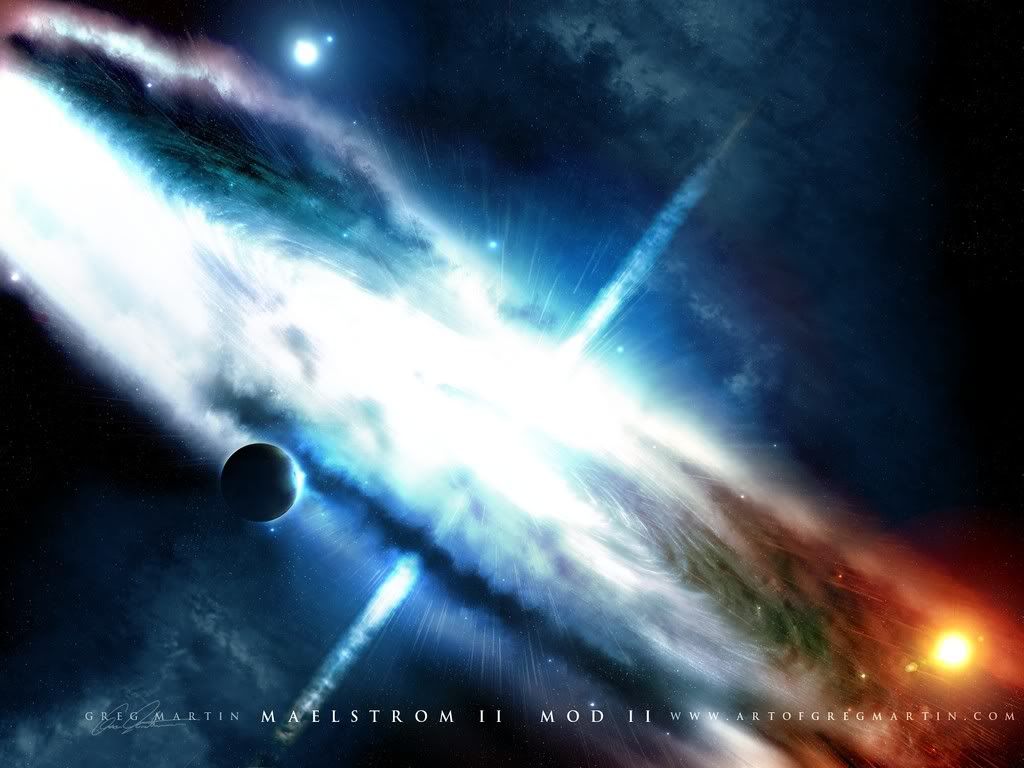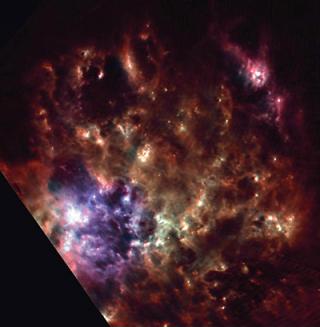---------------------
Loosely speaking, a black hole is a region of space that has so much mass concentrated in it that there is no way for a nearby object to escape its gravitational pull. Since our best theory of gravity at the moment is Einstein's general theory of relativity, we have to delve into some results of this theory to understand black holes in detail, but let
 's start of slow, by thinking about gravity under fairly simple circumstances.
's start of slow, by thinking about gravity under fairly simple circumstances. Suppose that you are standing on the surface of a planet. You throw a rock straight up into the air. Assuming you don't throw it too hard, it will rise for a while, but eventually the acceleration due to the planet's gravity will make it start to fall down again. If you threw the rock hard enough, though, you could make it escape the planet's gravity entirely. It would keep on rising forever. The speed with which you need to throw the rock in order that it just barely escapes the planet's gravity is called the "escape velocity." As you would expect, the escape velocity depends on the mass of the planet: if the planet is extremely massive, then its gravity is very strong, and the escape velocity is hi gh. A lighter planet would have a smaller escape velocity. The escape velocity also depends on how far you are from the planet's center: the closer you are, the higher the escape velocity. The Earth's escape velocity is 11.2 kilometers per second (about 25,000 m.p.h.), while the Moon's is only 2.4 kilometers per second (about 5300 m.p.h.).
gh. A lighter planet would have a smaller escape velocity. The escape velocity also depends on how far you are from the planet's center: the closer you are, the higher the escape velocity. The Earth's escape velocity is 11.2 kilometers per second (about 25,000 m.p.h.), while the Moon's is only 2.4 kilometers per second (about 5300 m.p.h.).
Now imagine an object with such an enormous concentration of mass in such a small radius that its escape velocity was greater than the velocity of light. Then, since nothing can go faster than light, nothing can escape the object's gravitational field. Even a beam of light would be pulled back by gravity and would be unable to escape.
The idea of a mass concentration so dense that even light would be trapped goes all the way back to Laplace in the 18th century. Almost immediately after Einstein developed general relativity, Karl Schwarzschild discovered a mathematical solution to the equations of the theory that described such an object. It was only much later, with the work of such people as Oppenheimer, Volkoff, and Snyder in the 1930's, that people thought seriously about the possibility that such objects might actually exist in the Universe. (Yes, this is the same Oppenheimer who ran the Manhattan Project.) These researchers showed that when a sufficiently massive star runs out of fuel, it is unable to support itself against its own gravitational pull, and it should collapse into a black hole.
In general relativity, gravity is a manifestation of the curvature of spacetime. Massive objects distort space and time, so that the usual rules of geometry don't apply anymore. Near a black hole, this distortion of space is extremely severe and causes black holes to have some very strange properties. In particular, a black hole has something called an 'event horizon.' This is a spherical surface that marks the boundary of the black hole. You can pass in through the horizon, but you can't get back out. In fact, once you've crossed the horizon, you're doomed to move inexorably closer and closer to the 'singularity' at the center of the black hole.
You can think of the horizon as the place where the escape velocity equals the velocity of light. Outside of the horizon, the escape velocity is less than the speed of light, so if you fire your rockets hard enough, you can give yourself enough energy to get away. But if you find yourself inside the horizon, then no matter how powerful your rockets are, you can't escape.
The horizon has some very strange geometrical properties. To an observer who is sitting still somewhere far away from the black hole, the horizon seems to be a nice, static, unmoving spherical surface. But once you get close to the horizon, you realize that it has a very large velocity. In fact, it is moving outward at the speed of light! That explains why it is easy to cross the horizon in the inward direction, but impossible to get back out. Since the horizon is moving out at the speed of light, in order to escape back across it, you would have to travel faster than light. You can't go faster than light, and so you can't escape from the black hole.
(If all of this sounds very strange, don't worry. It is strange. The horizon is in a certain sense sitting still, but in another sense it is flying out at the speed of light. It's a bit like Alice in "Through the Looking-Glass": she has to run as fast as she can just to stay in one place.)
Once you're inside of the horizon, spacetime is distorted so much that the coordinates describing radial distance and time switch roles. That is, "r", the coordinate that describes how far away you are from the center, is a timelike coordinate, and "t" is a spacelike one. One consequence of this is that you can't stop yourself from moving to smaller and smaller values of r, just as under ordinary circumstances you can't avoid moving towards the future (that is, towards larger and larger values of t). Eventually, you're bound to hit the singularity at r = 0. You might try to avoid it by firing your rockets, but it's futile: no matter which direction you run, you can't avoid your future. Trying to avoid the center of a black hole once you've crossed the horizon is just like trying to avoid next Thursday.
How big is a black hole?
------------------------
There are at least two different ways to describe how big something is. We can say how much mass it has, or we can say how much space it takes up. Let's talk first about the masses of black holes.
There is no limit in principle to how much or how little mass a black hole can have. Any amount of mass at all can in principle be made to form a black hole if you compress it to a high enough density. We suspect that most of the black holes that are actually out there were produced in the deaths of massive stars, and so we expect those black holes to weigh about as much as a massive star. A typical mass for such a stellar black hole would be about 10 times the mass of the Sun, or about 10^{31} kilograms. (Here I'm using scientific notation: 10^{31} means a 1 with 31 zeroes after it, or 10,000,000,000,000,000,000,000,000,000,000.) Astronomers also suspect that many galaxies harbor extremely massive black holes at their centers. These are thought to weigh about a million times as much as the Sun, or 10^{36} kilograms.
The more massive a black hole is, the more space it takes up. In fact, the Schwarzschild radius (which means the radius of the horizon) and the mass are directly proportional to one another: if one black hole weighs ten times as much as another, its radius is ten times as large. A black hole with a mass equal to that of the Sun would have a radius of 3 kilometers. So a typical 10-solar-mass black hole would have a radius of 30 kilometers, and a million-solar-mass black hole at the center of a galaxy would have a radius of 3 million kilometers. Three million kilometers may sound like a lot, but it's actually not so big by astronomical standards. The Sun, for example, has a radius of about 700,000 kilometers, and so that supermassive black hole has a radius only about four times bigger than the Sun.







 Great Red Spot, which may be a huge storm in the atmosphere. If so it must be quite a storm, as it has been recorded for 300 years!
Great Red Spot, which may be a huge storm in the atmosphere. If so it must be quite a storm, as it has been recorded for 300 years! 
























